nothingnew
Tag: mfuk20161101
ADnew
AD
AD
AD
AD
Golden touch
Congratulations on your huge Olympic success. Has it sunk in yet?
No, it hasn’t! It still feels a bit weird. I haven’t been back in the UK long and it’s been quite busy – but it’s good. It will take a long time to really sink in.
You won two golds in about an hour: first on the floor where you weren’t among the favourites, and then on the pommel horse where you were. Were you worried that the surprise win would cost you in your strongest event?
No. I just had to forget about it. I still had a job to do.
Wait, you just forgot that you’d won a gold medal?!
Yes [laughs] – obviously that was really, really hard to do! My aim was to make the Olympic floor final, because that would have been a first for me, and I thought it would help me ease myself in for my strongest event, the pommel. So making the floor final was a huge bonus, and to then win the gold – it hit me hard. But I had 30 minutes to get back to the training gym and block everything out of my head, because I still had one more job to do.
When did you realise you’d won that first gold?
I saw my score and that I’d gone into first place, but to be totally honest I didn’t know what was going on. My team-mates and coaches were saying, “Max, do you want to know what soand-so just scored?” and I was begging them not to tell me! Then after the last guy went and made a slight mistake my coach nudged me and told me I was an Olympic champion.
Did you know you’d done enough on the pommel to win the second gold?
I got off and thought I’d done well, but I had no idea how Louis [Smith, Whitlock’s team-mate whom he beat into second place] had done, or anyone else who had gone before me. From a young age I’ve never watched any rival gymnasts perform when competing. All I can do is focus on my job of performing to the best of my ability, and I was happy because I’d done my job and got through my routine clean. I knew that if I did that I stood a good chance.
How did you cope with such intense pressure?
It was completely different to London 2012 because I was the young kid who wasn’t expected to do much. Rio was different. I felt like I had to deliver and the whole team were expected to come back with medals. So there was pressure and I was nervous, but I blocked that out. I’ve been training for years to deliver in critical moments, and all my hard training paid off.
Where do you get confidence from? A successful training camp?
Absolutely. That’s vital for me. If I have a good build-up before a competition then that really takes the pressure off. If you know deep down that there’s nothing more you could have done it gives you confidence that you’re ready. My build-up for Rio was great and I arrived feeling good, without any niggles, and my confidence was high.
Is training a case of practice makes perfect?
Yeah, it’s about muscle memory and putting in the hours until it becomes completely natural. I even practice making mistakes on purpose so that if it does happen, my muscle memory kicks in and I can get out of trouble straight away. Take the pommel: ideally you want the routine to be straight legs and pointed toes with a clean dismount. But I’ll do a routine scruffy, with bent legs, so I know what to do if that happens when it matters.
How you bounce back from competition disappointment?
You have to learn from the mistakes. There have been competitions where I haven’t done as well as I wanted and these are the times that I learned the most. You have to find a positive from every setback. You have to look deep inside yourself and when you do it moves you forward.
Max Whitlock is a Myprotein ambassador. Visit myprotein.com
Add muscle and torch fat
Some people claim it’s impossible to burn body fat and burn muscle at the same time, believing that you have to prioritise one training goal over the other. That’s not the case – but to achieve both simultaneously, you have to start training smarter. This month’s main workout will get you doing just that because each week it combines two total-body sessions, taxing all your muscles to initiate the fat-burning process, with two upper-body muscle-building sessions, which will add lean mass across your torso. The result is that you will transform your physique by stripping away unwanted fat from across your middle while sculpting a bigger, stronger body.
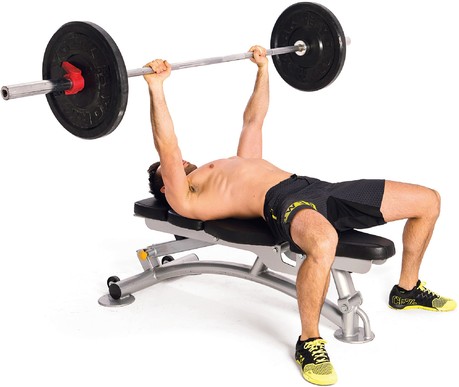
Photography Tom Miles, Glen Burrows Models Greg Cornthwaite, Daniel Ventura
HERE’S HOW THE PLAN WORKS
This month’s four-week workout is made up of four sessions a week. Workout one is a total-body session; workout two targets your chest and back; workout three is another total-body session; and workout four hits your arms and shoulders. This approach gives you the fat-burning benefits of two tough full-body workouts per week and the muscle-building benefits of also hitting the major muscles of your upper body with their own dedicated session.
Each workout is made up of five moves. The first two moves are big, compound lifts done in a superset for four sets of 12 reps to get your heart rate high and muscles pumped. The final three moves make up a tri-set, which means you’ll do them in order with minimal rest until you’ve completed all the reps of the third move. Do the workouts in order, sticking to the sets, reps, tempo and rest periods detailed, and you’ll blast away your belly fat while also adding lean muscle mass to your chest, arms, shoulders and back, giving you your best ever body after just four weeks.
TEMPO TRAINING
To get the full effect from these workouts, you need to stick to the four-digit tempo code for each exercise. The first digit indicates how long in seconds you take to lower the weight, the second how long you pause at the bottom of the move, the third how long you take to lift the weight, and the final digit how long you pause at the top. The accumulated time under tension increases your heart rate to burn body fat and break down muscle tissue so it’s rebuilt bigger and stronger. Keep each rep smooth and controlled so your muscles – not momentum – do the work, and move through a full range of motion.
Your four-week total body plan
Here’s how each week of the plan is structured

Workout 1
TOTAL BODY
1A SQUAT
Sets 4 Reps 12
Tempo 2010 Rest 30sec
Stand tall with a bar across the backs of your shoulders. Keeping your chest up and core braced, squat down as deep as you can. Drive back up through your heels to return to the start.

1B TRICEPS DIP
Sets 4 Reps 12
Tempo 2010 Rest 60sec
Grip rings or parallel bars with your arms straight. Keeping your chest up, bend your elbows to lower your body as far as your shoulders allow. Press back up powerfully to return to the start.

2A GLUTE BRIDGE
Sets 4 Reps 12
Tempo 2111 Rest 10sec
Lie with your upper back supported on a bench, holding a barbell across the tops of your thighs. Thrust your hips up, squeeze your glutes at the top, and then return to the start.

2B INCLINE DUMBBELL CURL
Sets 4 Reps 12
Tempo 2111 Rest 10sec
Sit on a bench angled at 45° with dumbbells by your sides, palms facing forwards. Keeping your elbows tucked in, curl the weights up, squeezing your biceps at the top. Lower them back to the start.

2C SEATED OVERHEAD PRESS
Sets 4 Reps 12
Tempo 2010 Rest 60sec
Sit on an upright bench with a dumbbell in each hand at shoulder height. Keeping your chest up, press the weights directly overhead until your arms are straight, then lower them back to the start.

Workout 2
CHEST AND BACK
1A BENCH PRESS
Sets 4 Reps 12
Tempo 2010 Rest 30sec
Lie on a flat bench holding a barbell with your hands slightly wider than shoulder-width apart. Brace your core, then lower the bar towards your chest. Press it back up to the start.

1B BENT-OVER ROW
Sets 4 Reps 12
Tempo 2010 Rest 60sec
Hold a barbell with an overhand grip, hands just outside your legs. Hinge forwards from your hips, brace your core, then pull the bar up, leading with your elbows. Lower it back to the start.
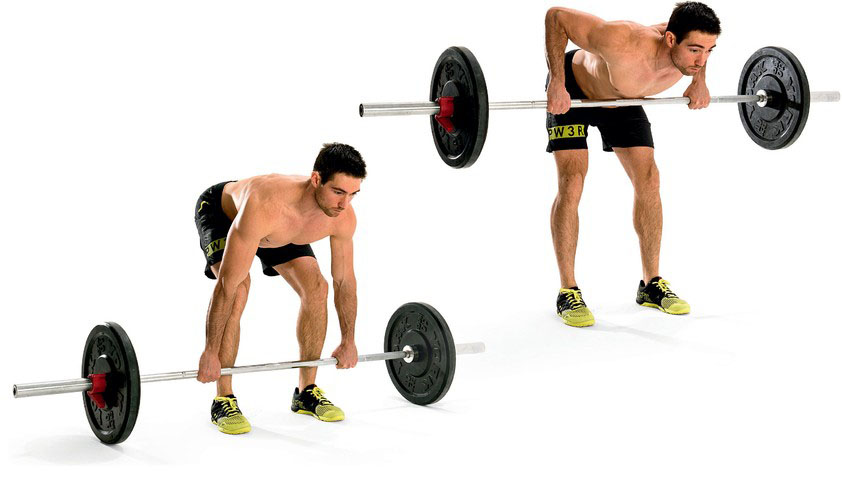
2A INCLINE DUMBBELL PRESS
Sets 4 Reps 12
Tempo 2010 Rest 10sec
Lie on an incline bench holding a dumbbell in each hand by your shoulders. Brace your core, then press the weights up until your arms are straight. Lower them back to the start.

2B INCLINE DUMBBELL FLYE
Sets 4 Reps 12
Tempo 2010 Rest 10sec
Lie on an incline bench holding a dumbbell in each hand above your face, with your palms facing and a slight bend in your elbows. Lower them to the sides, then bring them back to the top.

2C ONE-ARM ROW
Sets 4 Reps 12 each side
Tempo 2111 Rest 60sec
Kneel on a bench with one hand on it for support, holding a dumbbell in the other hand. Keeping your chest up, row the weight up, leading with your elbow, then lower back to the start. Complete all the reps on one side, then switch.

Workout 3
TOTAL BODY
1A FRONT SQUAT
Sets 4 Reps 12
Tempo 2010 Rest 30sec
Stand tall with a bar across the front of your shoulders with elbows up. Keeping your core braced, squat down as deep as you can. Drive back up through your heels to return to the start.

1B RACK PULL
Sets 4 Reps 12
Tempo 2010 Rest 60sec
Stand tall in front of a barbell resting on safety bars at knee height. Using a double overhand grip, bend down and deadlift the bar up, squeezing your shoulder blades together at the top.

2A GOOD MORNING
Sets 4 Reps 12
Tempo 2111 Rest 10sec
Stand tall holding a light barbell across the backs of your shoulders, feet shoulder-width apart. With your core braced, bend forward slowly from the hips, as far as your hamstrings allow but not past horizontal. Return to the start.

2B REVERSE FLYE
Sets 4 Reps 12
Tempo 2010 Rest 10sec
Bend forward from the hips with a light dumbbell in each hand with palms facing. Keeping a slight bend in your elbows, raise the weights out to shoulder height, then lower back to the start.

2C BARBELL ROLL-OUT
Sets 4 Reps 12
Tempo 2111 Rest 60sec
Kneel on the floor holding a barbell with both hands. Roll the bar forward so you lower your torso, keeping your core braced. Then use your abs muscles to return to the start.

Workout 4
ARMS AND SHOULDERS
1A CHIN-UP
Sets 4 Reps 12
Tempo 2010 Rest 30sec
Hold a bar with an underhand grip. Brace your core, then pull yourself up until your chin is higher than the bar. Lower until your arms are straight again.
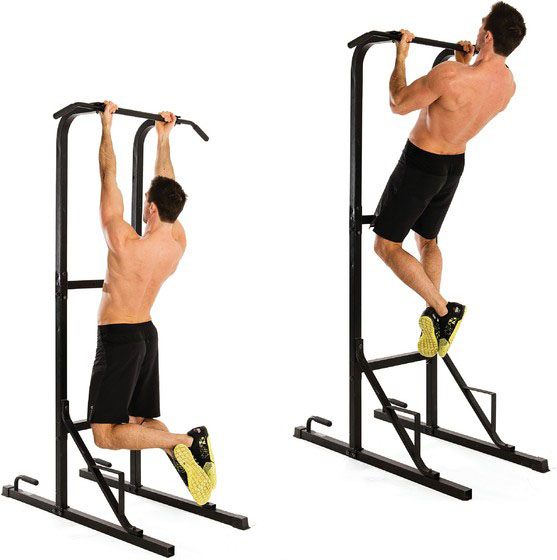
1B OVERHEAD PRESS
Sets 4 Reps 12
Tempo 2010 Rest 60sec
Hold a barbell across the top of your chest with your hands slightly wider than shoulder-width apart. Keeping your chest up and core braced, press the bar overhead until your arms are straight. Lower it back to the start.

2A STANDING DUMBBELL BICEPS CURL
Sets 4 Reps 12
Tempo 2010 Rest 10sec
Stand with dumbbells by your sides, palms facing forwards. Keeping your elbows tucked in, curl the weights up, squeezing your biceps at the top. Lower them back to the start.
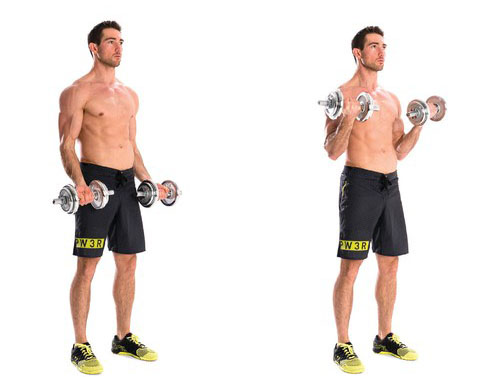
2B TRICEPS EXTENSION
Sets 4 Reps 12
Tempo 2111 Rest 10sec
Stand tall holding a dumbbell over your head with both hands, arms straight. Keeping your chest up, lower the weight behind your head, then raise it back to the start.
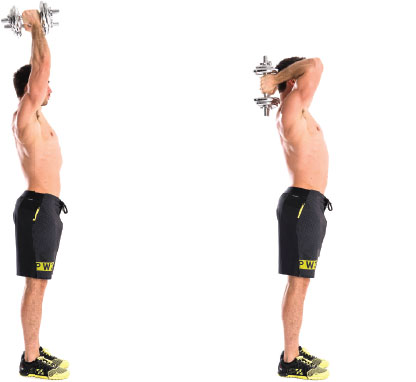
2C LATERAL RAISE
Sets 4 Reps 12
Tempo 2111 Rest 60sec
Stand tall, holding a light dumbbell in each hand with palms facing. Keeping your chest up and a bend in your elbows, raise the weights out to shoulder height, then lower back to the start.

Ball to the wall
When you think of explosive power, your first thought is likely of sprinters or strongmen who need to move a weight (or themselves) from point A to point B as quickly as they can. But building explosive power won’t just make you faster or stronger, it will also help you build more lean muscle mass in less time. That’s because the quicker and harder you can contract a muscle, the more weight you can lift, and the more tension you can place upon it both during the concentric (lifting) part of a rep as well as the eccentric (lowering) part too. Fortunately, improving your explosiveness is simple. Try this five-move workout that requires just one bit of kit – a medicine ball – to fire up your muscles and build the explosive speed and power that will transform your training and performance, as well as your physique.
Pick a med ball at a weight that allows you to perform all the exercises explosively – the main aim here is to develop speed
POWER UP
This workout has five moves. The first four moves are paired in supersets. Do all five reps of move 1A, rest for 10sec, then do all five reps of 1B, then rest for 60sec. Repeat this for five sets, then move on to moves 2A and 2B and follow the same pattern.
The final move is performed as a straight set. Focus on keeping your abs, lower back and glutes engaged for every rep of every set to keep your body stable and improve power transfer between your upper and lower body.





Keep your heels off the floor for the duration of the set to keep your lower abs engaged and work your muscles harder
Beat the clock
Enter the FitBrit Challenge today and get your FREE 3-day Fitness First gym pass at fitnessfirst.co.uk/fitbrit
START STRONG
The best way to warm up for the FitBrit Challenge, and your training sessions before it, is to get your pulse raised and test yourself on each exercise. It’s important to keep your warm-ups specific to the task in hand. So once you’ve got your heart rate up on the treadmill, bike or rower, perform the challenge’s resistance moves with around 40-50% of the weight for half the reps. This will keep your pulse up, as well as preparing both your mind and your muscles so you’re ready to start strong.
UP THE EFFORT
To ensure you give yourself the best odds of setting a red-hot time, practise doing the full challenge but halving the reps for the resistance moves and halving the distances for the cardio parts. This will allow you to go all-out for the duration of the session to build speed and stamina. Next time, do 75% for each part of the event. Not only will this help you perform physically, but it will also give you confidence and belief in your ability.
PACE YOURSELF
The biggest mistake people make when trying to set a good FitBrit time is setting off too fast. It’s tempting to hit the 800m run hard – because it’s the first exercise, you start it feeling strong and fresh. But going too hard too soon will empty your tank. Start at 70% of the effort you’d normally exert for 800m, then perform the next three moves (30 24kg kettlebell swings, 20 20kg ViPR tilts and 10 burpee box jumps) at a steady pace. Then you can really push hard on the 1.5km bike – this is where you can make up the most time, so focus on a high RPM to eat up the clock.
USE YOUR HEAD
Ask anyone who has ever completed the FitBrit Challenge and they will tell you how tough they found it. Not just physically, but also mentally. Even though you’re likely to be doing it in the middle of a busy gym, you’ve got to stay focused on what you’re doing and not allow mental fatigue to set it. Stick to your plan and concentrate only on the event at hand. Thinking about the next event or how much you still have to do before the finish will only harm your chances of setting a new best time.
FINISH FAST
Once you get off the bike, you have three resistance exercises to get done quickly: 10 parallette shooters, 20 20kg kettlebell sumo deadlift to high pull and 30 7kg sandbell rainbow slams. These are tough, especially after a hard ride, but it’s a good idea to keep each move fast but consistent to get to the final event – the 500m row – in good shape. The row is your opportunity to empty your tank and really go for your best possible time. Leave nothing on the gym floor – this is where you can make or break your FitBrit Challenge.
Kettlebell moves for cast-iron abs
Bodyweight moves are great for developing a foundation of abdominal size and strength – but if you want to sculpt a rock-solid six-pack, you’ll need to start adding resistance. One of the most effective tools for the job is a kettlebell. “I use kettlebells for abs moves because they’re versatile,” says Ashton Turner from London’s Evolve 353 gym. “Single-sided moves make you unbalanced so your body has to work harder to keep you stable. Any overhead move, like a windmill, will also require good core strength to stabilise your spine.”
HOW TO DO IT
Do three sets of ten reps for each exercise, resting for 45 seconds between sets and 90 seconds between exercises. For single-sided exercises such as the side press, do two sets on each side, alternating sides each set. To keep progressing, add a rep to every set each time you train, until you’re doing 15 reps in each set. After that, use a heavier kettlebell and go back to doing ten reps.
WHY IT WORKS
The moves in this workout will help you develop your anti-rotation abilities, which enable you to resist being pulled out of position. “It’s one thing to train rotational strength but you need to control anti-rotation first,” Turner says. They will also give you a comprehensive abs and core workout, targeting your rectus abdominis (the sheet of muscle that makes up your six-pack), side abs and lower back.

MEET THE EXPERT
Ashton Turner is the co-founder of Evolve 353 gym in London (evolve353.com).
He has worked with clients across multiple training disciplines including kettlebells, Olympic lifting, strength and conditioning and Pilates.

1 ROLLING THUNDER
HOW Lie on your back and hold a kettlebell in each hand by your chest. Straighten one arm and push upwards so your shoulder leaves the floor and you twist your torso. As you lower that kettlebell, extend the other arm to create a smooth rhythm.
EXPERT TIP “Lying on the floor reduces the instability, and therefore the risk, of the exercise,” says Turner. “I get people to think about imprinting their lower back on the floor. That will help you to avoid overarching your lower back and switching off your abdominal muscles.”

2 WINDMILL
HOW Start with the weight above your head and your feet wider than shoulder-width apart. Your weight distribution should be biased towards the side that’s holding the bell. Look at the bell and, keeping your eyes on it, lower your torso until your hand touches the floor.
EXPERT TIP “Windmills look intimidating but they are an excellent move for building core stability and shoulder stability because they require a lot of control,” says Turner. “They also give you a good hamstring stretch.”

“Always look at the kettlebell throughout the move,” says Turner. “That will help you stay stable and avoid putting too much stress on your shoulder joint”
3 SIDE PRESS
HOW Start with the kettlebell at shoulder height. Brace your core and lower your torso to one side while simultaneously straightening your arm. Aim to keep the kettlebell in place so that it barely moves – instead, your body should move away from it. From there, reverse the move back to the start.
EXPERT TIP “This is a great obliques – side abs – exercise because you have to stabilise your torso as you push the weight away from your body,” says Turner. “As you get lower, the intensity of the exercise increases and your centre of mass changes. That forces you to think about the constantly changing kettlebell movement and instability as you go through the exercise.”
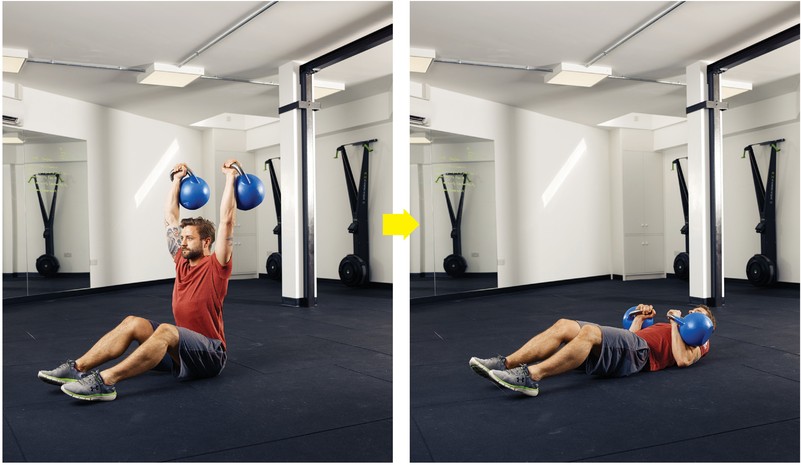
4 ANGEL PRESS
HOW Start by sitting down with your knees bent, holding two kettlebells overhead. Slowly lower towards the floor while bringing the kettlebells down to your chest. Contract your abs to raise your torso while simultaneously extending your arms.
EXPERT TIP “Once you’re sitting up straight, tuck your pelvis under and, as you lower, ‘roll through’ your spine so you’re trying to make contact with the ground one vertebra at a time,’ says Turner. “Going slowly on this move will make your abs work harder.”

5 PLANK DRAG
HOW Get into a straight-arm plank position with your body in a straight line from head to heels, with a kettlebell positioned on one side of your body. Reach under your torso to drag the bell across to the other side. Switch hands and repeat the move.
EXPERT TIP “This is great way of making the plank more interesting,” says Turner. “The wider you take the kettlebell, the hard it is to do. You can also try raising the kettlebell off the floor slightly to turn it into a modified reverse flye.”
9 ways to boost your endurance
SWIMMING
FOCUS YOUR TRAINING
“Aim to do two 20- to 30-minute technique sessions during the week where you focus on improving a specific aspect of your stroke like your breathing or kicking,” says Sam Williams, swimming coach at Swim Studio London (swimstudiolondon.com). “Then do a longer session at the weekend where you add extra lengths or time each week to monitor your progress.”
STAY RELAXED
“Endurance sports like cycling and running are all about exertion, but if you’re doing it properly, swimming should be the opposite,” says Williams. “If you’re too tense in the water, you’ll end up thrashing around, wasting energy and tiring yourself out. Instead, focus on staying balanced in the water and maintaining a relaxed stroke.”
KNOW YOUR KIT
“Make sure you train wearing and using the kit you plan to race in,” says Williams. “You wouldn’t try to break a new pair of running shoes in the week before a marathon, and swimming is no different – the last thing you want is a new pair of goggles that start letting in water on race day. Having battle-tested gear that you trust and feel comfortable in for hours at a time will stand you in good stead.”
CYCLING
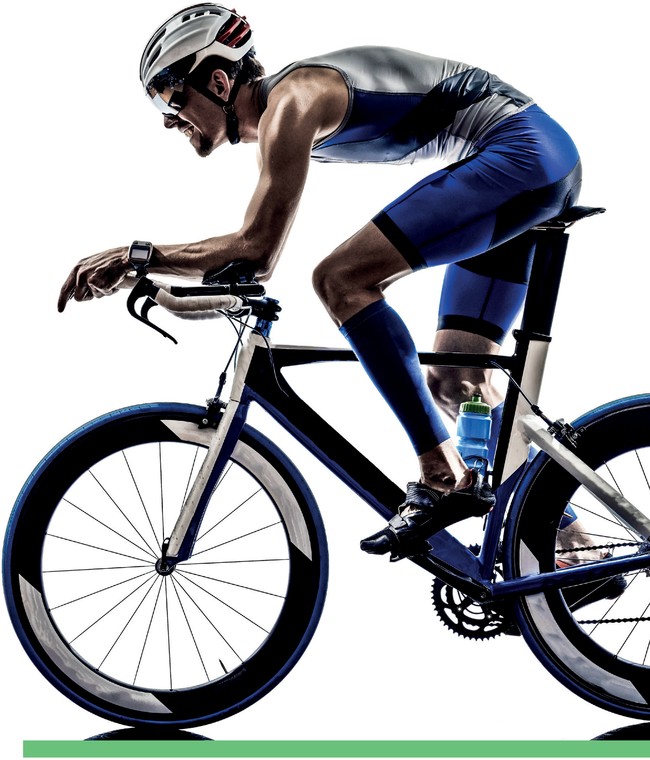
Photography iStock
FREQUENCY IS KEY
“Aim to ride every other day if you can, making sure you have at least three rest days a week,” says Cyclist magazine’s James Spender. “Even if you only have time for short, 30-minute sessions, a few of these spread across the week will be more productive than just doing one three-hour ride on the weekend. The regularity will help you become more comfortable on the bike and improve your muscle memory for pedalling.”
NAIL YOUR NUTRITION
Using the correct fuel will help you train and recover to the best of your abilities. “Have an easily digestible meal that combines healthy carbs and protein – say, wholegrain rice with chicken breast and green veg – about two hours before your session and a similar meal afterwards,” says Spender. “During the ride, top up your energy levels with a bar, gel or swig of energy drink at 20-minute intervals once you pass the two-hour mark.”
LEARN ROADSIDE REPAIRS
It might sound obvious, but being able to change a flat tyre is an absolute must, whatever your level of fitness or experience. “Even if you’ve never had one before, do a practice run during training to familiarise yourself with the process,” says Spender. “You can’t always rely on having other cyclists around to help you if something goes wrong, and the last thing you’d want is for a mid-race puncture to undo all your hard work.”
RUNNING
MAKE A HAPPINESS PLAN
Even if you stick perfectly to your schedule, it’s not a given that you’ll feel great while you’re training. “It’s normal at times to feel unhappy about how you performed in a training session,” says Kim Ingleby, a British Athletics Coach and personal trainer. “So write down the runs that you’ve really enjoyed and how they made you feel. Then write down what you are unhappy about. Write these on one side of the paper and then, on the other side, write down what you can do to become happier with them. From that list, choose a maximum of three areas to focus on each month to improve and create goals that you can work on.”
FIND MID-SESSION STRENGTH
During hard training sessions there can be a voice in your head telling you to stop. “This is so common, and it’s our mind’s way of looking after us,” says Ingleby. “When this happens you have two options. First, you can decide you are going to walk or slow down for a minute and get your focus back, breathe deeply and start again. Second, breathe it out: as you inhale, say a positive word like ‘strength’ and exhale out the stopping thought for six breaths, focusing on growing in strength and letting go of fatigue. This sounds too simple to work – but it does.”
GET A WINNING MINDSET
Towards the end of any race, whether it’s a 10K or a triathlon, is where the going really gets tough. “When you start to struggle, think of all the people who inspire and motivate you, the people you love in your life and your reasons for taking part in the event,” says Ingleby. “I also find it useful to break the longer running events into 5km or 10km chunks so that as you complete each one, you realise you can do it. Another trick is to have a mini-movie or soundtrack in your mind for near the end, which you can ‘play’ to keep you going until you cross the finish line.”
ON OPTIMUM NUTRITION
Cover model secrets
Your blueprint for success
When Shaun Stafford was forced to hang up his rugby boots because of a career-ending injury, he turned his focus from training for performance to training for physique. And he hasn’t looked back. In the six years since, his dedication has built a body that’s been rewarded with not one but two World Beauty, Fitness and Fashion (WBFF) titles. Discover his training, diet and recovery secrets so you too can make big changes to how you look with your top off.
Model ambition
World champion fitness model Shaun Stafford reveals how he builds and maintains his award-winning body
How did you get into fitness modelling?
I used to play rugby but that came to an end because of injury, so I had nothing left to train for. This was about six years ago. At the time the fitness show phenomenon was just beginning, so a mate mentioned it to me and I decided to give it a try. I won the first one I entered and from then on I was hooked. I did some research into the industry and came across the WBFF, so I started entering their shows.
How did you find the transition from training for a team sport to an individual one?
The training didn’t really change – the main difference was the diet. As a rugby player I was almost always in a calorie surplus, but training for physique rather than performance alone, you’re doing it in a calorie deficit where you want to hold on to muscle tissue but lose body fat. The most important thing is to learn what works for you. You need to give yourself enough time to lose weight, to build muscle or whatever your goal is. Then you can fine-tune the techniques that you know work for you.
What’s the hardest part of preparing for a competition or shoot?
You need to develop a certain mindset. If you want to give it everything you’ve got – and you need to if you want to make a big change – then you have to follow the principle of train, eat, sleep, repeat. The problem with this mentality is that you don’t exist in a little bubble. There are other people in your life who have to bear the brunt of that – friends, family, colleagues. You have to be single-minded and it’s a very selfish existence. During prep you are not fun to be around!
How did becoming a dad affect your training and diet?
My current prep has been the hardest I’ve ever done. I have a one-year-old boy so I am awake one hour earlier and up at least two hours later each weekday, and then you don’t have much time to yourself at weekends. Having kids makes getting into shape harder, but there are ways to make it easier – stay on top of your diet and cram in your workouts when you can, like training during your lunch break, which is a great option to let you use your time more efficiently. Book training sessions into your diary like meetings. I used to train in late afternoon, but I’ve shifted it to the morning now, and that has massively helped. It means I am working out while I am still energised, whereas by late afternoon I am exhausted and can’t train with the required intensity.
How important is it that you find some life balance?
It’s 100% imperative to find a balance. You need to spend time with your mates or your loved ones during any hard contest prep or during a transformation challenge because it makes you feel human, rather than like a robot who only trains, eats and sleeps! Happiness is key to a successful transformation. Yes, you have to go through a tough process to get a result, but it won’t work if you hate that all you’re doing is working out or you’re just obsessing about the foods you’re not eating – it has to be sustainable over a long period of time. To make a long-term change, you have to find some balance.
What are the common reasons that people fail to build the body they want?
A lot of people lose their way because they don’t have a timeframe. Everyone wants to look a little better, but without setting a deadline, it’s so easy to let it slip. Setting a goal, giving it a realistic timeframe that’s tough but achievable, then breaking that down into mini targets you can tick off each week is one of the best ways to stay in control and to stay motivated.
Tell us about the workout you’ve put together over the following pages.
There are three workouts, one for arms, one for shoulders and one for abs. Each workout is based around tri-sets, which is where you do three moves back to back with minimum rest. When you want to increase training intensity, and especially if you haven’t got much time to train, tri-sets give you the ability to hit a muscle group in a variety of ways in a very efficient way. They also increase the training volume you can do, which is one of the most important factors behind building new muscle tissue.
Shaun Stafford is an Optimum Nutrition ambassador and performance director of City Athletic in London (cityathletic.co.uk). Turn over for his world title-winning upper-body workout

BUILD BIG ARMS
This biceps and triceps tri-set session will help you pack on arm muscle
Workout 1

How to do it
1 Start with the first triset, which works your biceps, beginning with 1A. Complete all the reps then move straight on to 1B, do all the reps, then move straight on to 1C.
2 After the final rep of 1C, rest for 90 seconds, then go back to the start. Repeat this pattern until you have done all three sets of the biceps tri-set.
3 Once you’ve completed the first tri-set and rested for 90 seconds, move on to the second tri-set, which works your triceps. Follow the exact same pattern, only resting after move 2C.
Tri-set 1 Biceps
1A DUMBBELL BICEPS CURL
Sets 3
Reps 12
Tempo 2111
Rest 0sec
Stand tall, holding a dumbbell in each hand. Curl the weights up, keeping your elbows close your sides, until they are at shoulder height. Pause, then lower them back down slowly.

1B DUMBBELL SPIDER CURL
Sets 3
Reps 12
Tempo 2111
Rest 0sec
Without putting the dumbbells down, bend forwards from your hips with straight arms. Curl the weights up towards your chin, pause, then lower them back down under control.

1C HAMMER CURL
Sets 3
Reps 12
Tempo 2111
Rest 90sec
Stand up and hold the weights with a palms-facing grip. With your elbows close to your sides, curl the weights up, keeping your palms facing one another. Pause at the top, then lower.

Tri-set 2 Triceps
2A TRICEPS EXTENSION
Sets 3
Reps 12 each side
Tempo 2111
Rest 0sec
Stand tall holding a dumbbell in one hand overhead. Slowly lower the weight behind your head, then straighten your arm to return to the start.
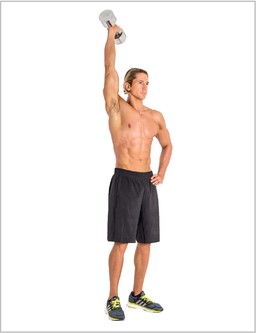
2B TRICEPS KICK-BACK
Sets 3
Reps 12 each side
Tempo 2111
Rest 0sec
Lean forwards from your hips, holding a dumbbell in one hand by your outer thigh. Raise the weight behind your body by straightening your arm. Pause, then return to the start.

2C DUMBBELL PRESS-UP
Sets 3
Reps 12
Tempo 2111
Rest 90sec
Start in a press-up position but holding dumbbells, with your hands close together. Lower your chest towards the floor, pause at the bottom, then press back to the start powerfully.
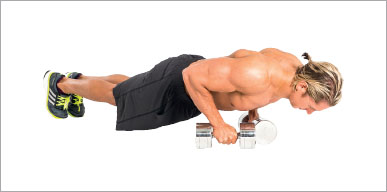
GET ROCK HARD ABS
A tri-set to sculpt a six-pack plus a finisher move adds up to your best ever body
Workout 2

Shaun Stafford’s six-pack secrets
1 “A lot of people think getting a six-pack is all about diet. Actually I know people who eat perfect diets but don’t have abs because they don’t train them. If you want the best set of abs possible then you have to dedicate training time to it.”
2 “You have to engage your abs and maintain tension on them for the duration of each set. The mind-tomuscle connection is huge for your abs, because if they’re not engaged you’re not working them fully and won’t get a peak contraction.”
3 “Focus on your breathing so that you’re fully exhaling on the contraction part of each move. This will ensure you keep your abs fully engaged and also stay mentally attuned to how they are working and feeling during each rep.”
1A RUSSIAN TWIST
Sets 3
Reps 25
Tempo 2111
Rest 0sec
Sit holding a dumbbell in both hands with your abs engaged. Keeping tension on your abs throughout, rotate fully to one side, back to the middle then across to the other side.

1B DUMBBELL V-SIT
Sets 3
Reps 15
Tempo 2111
Rest 0sec
Lie in a sit-up position holding a dumbbell in both hands. Raise your torso off the ground while bringing your knees in towards your chest. Return to the start and repeat.

1C DUMBBELL CRUNCH
Sets 3
Reps 15
Tempo 2111
Rest 90sec
Lie in a sit-up position holding a dumbbell across your chest. Keeping your feet on the floor, raise your torso off the ground and hold at the top. Return to the start and repeat.

2 DUMBBELL ROLLOUT
Sets 3
Reps 6-12
Tempo 2111
Rest 90sec
Kneel with a dumbbell in each hand. Lean forward from your hips and engage your core. Roll your hands away to lower towards the ground. Reverse back to the start.

SCULPT BROAD SHOULDERS
Add serious size across all three parts of your shoulder muscles to build a bigger, wider torso
Workout 3

How to do it
1 Start with the first tri-set, which works the whole shoulder joint, beginning with 1A. Complete the reps then move into 1B, do all the reps, then move straight into 1C.
2 After the final rep of 1C, rest for 90 seconds, then go back to the start. Repeat this pattern until you have done all three sets of the tri-set.
3 Once you’ve completed the first tri-set and rested for 90 seconds, move on to the second tri-set, which works the three muscles of your shoulders individually. Follow the exact same pattern, only resting after move 2C.
Tri-set 1 Shoulders
1A ARNOLD PRESS
Sets 3
Reps 12
Tempo 2111
Rest 0sec
Hold a dumbbell in each hand in front of your chest with palms facing your body. Press the weights up, rotating your wrists as you go, to end with palms facing away. Return to the start.

1B OVERHEAD PRESS
Sets 3
Reps 12
Tempo 2111
Rest 0sec
This move is a slightly easier version of the Arnold press because you start with palms facing away, and maintain this wrist position for the entire set. Keep each rep controlled.

1C ALTERNATING PRESS
Sets 3
Reps 12
Tempo 2111
Rest 90sec
Finishing the tri-set with alternating press means you work each arm individually to give the muscles slightly more time to recover between reps, so you can work them harder for longer.

Tri-set 2 Shoulders
2A REVERSE FLYE
Sets 3
Reps 12
Tempo 2111
Rest 0sec
Hold a light dumbbell in each hand and bend forwards from the hips. Raise the weights, leading with your elbows, then lower back to the start.

2B LATERAL RAISE
Sets 3
Reps 12
Tempo 2111
Rest 0sec
Stand tall with a dumbbell in each hand. Raise them to shoulder height, leading with your elbows. Pause at the top, then lower back to the start under control.

2C FRONT RAISE
Sets 3
Reps 12
Tempo 2111
Rest 90sec
This is like the previous move except instead of raising the weights to the sides, you raise them in front of you. Keep each rep slow, smooth and controlled for greater growth.
